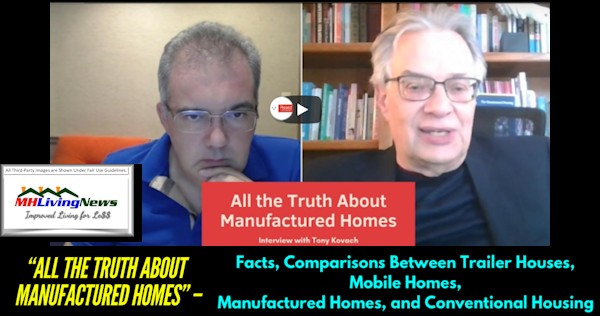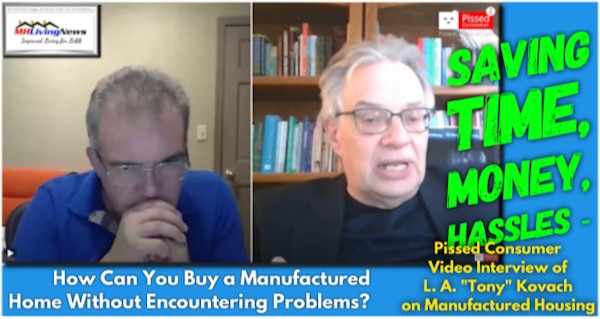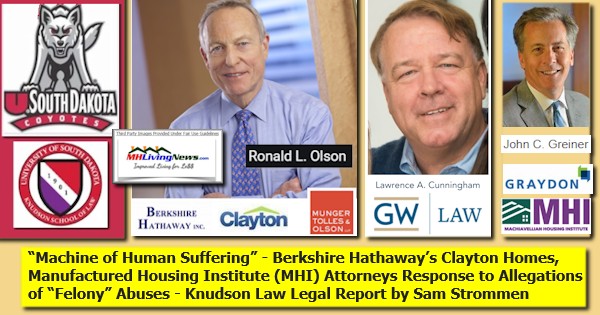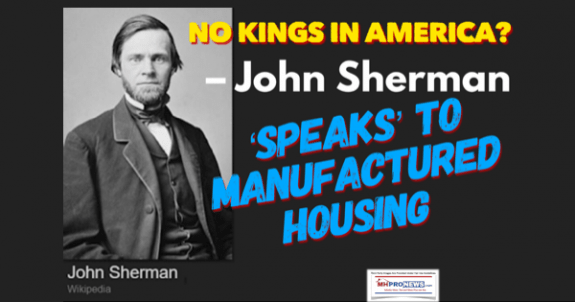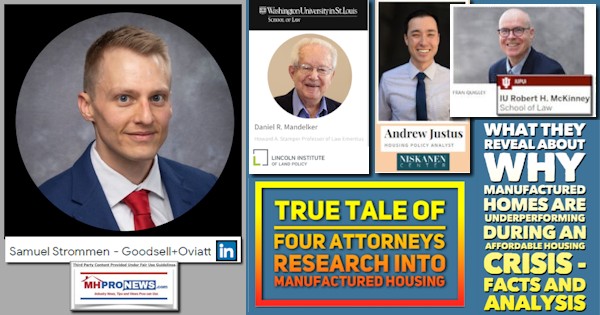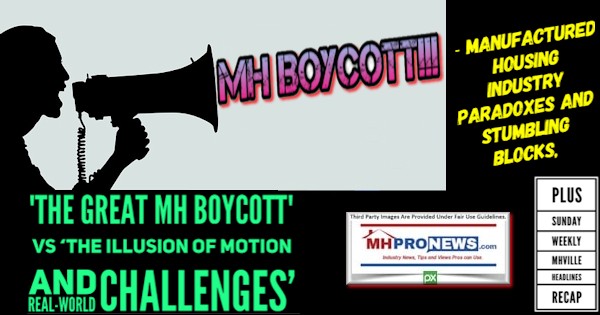
It was at the start of the third year of the Trump Administration that the Manufactured Housing Association for Regulatory Reform (MHARR) President and CEO Mark Weiss, J.D. presented an Issues and Perspectives article aptly entitled “The Illusion of Motion Versus Real-World Challenges.” Read this article as an insightful tee up to the headlines for the week in review, which follow in Part II. In Part III, today’s postscript, Weiss’ words will be contrasted with the public and brazen call for a boycott in manufactured housing.
History is important for a range of reasons. While this author disagrees with several of prior House Majority Whip James Clyburn (SC-D) inflationary and other policies, Clyburn was arguably spot on with these timeless remarks: “We study history in order to understand the present and prepare for the future. Because anything that’s happened before can happen again.”
Recall the arguably related maxim, ‘fool me once, shame on you, fool me twice, shame on me.’
With that brief tee up, see how relevant the now historic remarks by Weiss still are today. Note as a disclosure that perhaps 95 percent of the time, our sponsor MHARR has little or no clue on what is coming on MHProNews, other than they know that their monthly data and periodic Q&As or columns will at some point be published. But even the timing of that publishing may be unknown to MHARR, because we are each independent of the other. That’s said to make the point that Mark Weiss at MHARR may be as or more surprised by this flashback report as anyone else.
To set the context for Weiss’ thoughts, see the graphic below. Look at manufactured housing production was in 2019. Note that one of the points Weiss foresightfully made then which shocking-to-some aptly applies to the most recent manufactured housing downturn (See retailer report in Part II’s weekly recap). So, once more, history in some sense appears to be ‘repeating’ itself.
Highlighting of some remarks are added by MHProNews, but should not be a cause to miss a single word of what follows.
Notice: the graphic below can be expanded to a larger size.
See the instructions below the graphic below or click the image and follow the prompts.
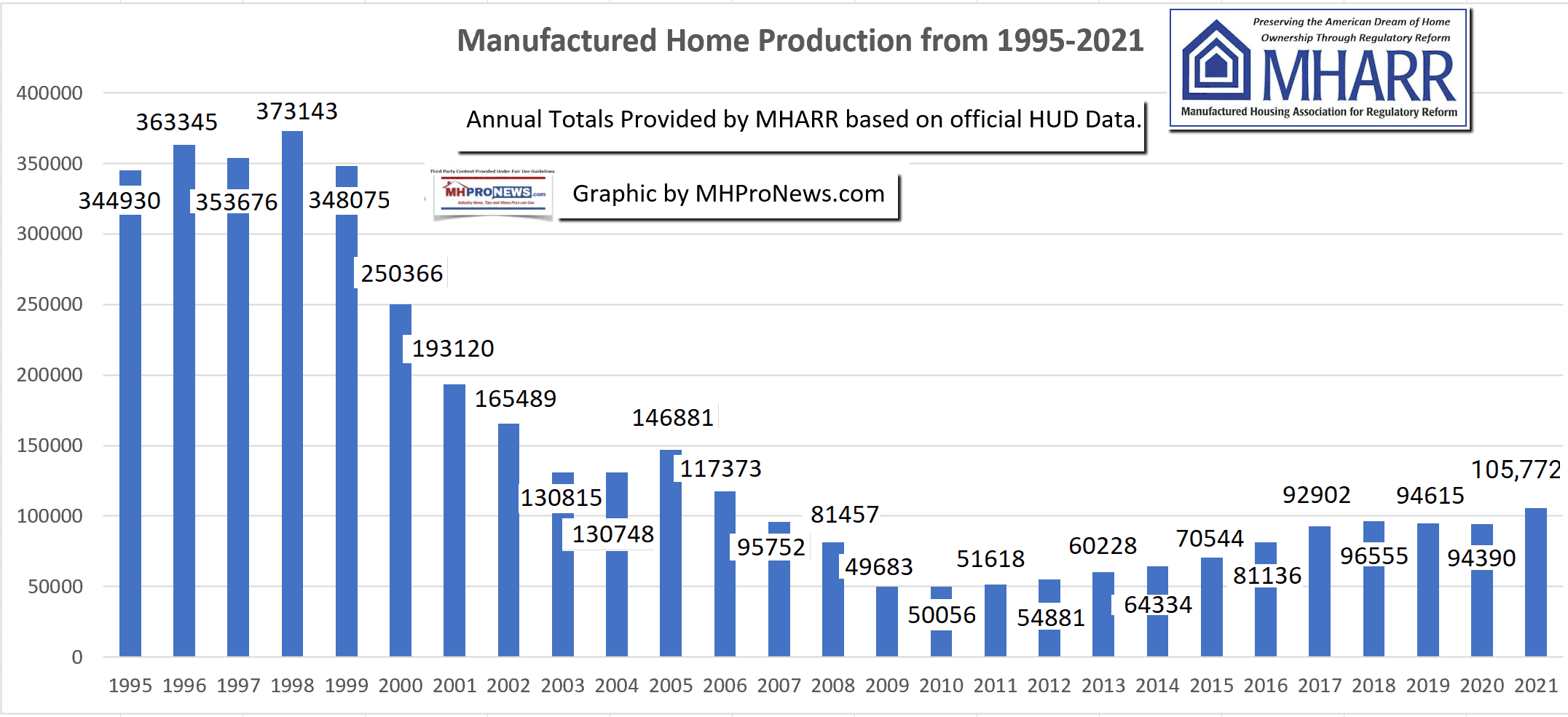
Part I
“The Illusion of Motion Versus Real-World Challenges”
January 23, 2019
Motion – or, more accurately, activity – in and of itself, is not necessarily synonymous with, or equivalent to, real progress, or, in fact, any progress at all. Recent reports emerging from elsewhere within the universe of organizations representing the manufactured housing industry paint a uniformly rosy picture of almost non-stop engagement, dialogue, meetings, conferences, photo-opportunities (presumably to prove the reality of the supposed engagement, dialogue, meetings and conferences) and other related confabs, particularly at the national level. This “good news” all the time meme, in turn, is replicated, repeated and touted by those who, for whatever reason, have determined that it is to their advantage to do so. Indeed, an entire new publication has appeared with the apparent mission of wet-nursing this meme. Meanwhile, others touting and promoting the new meme, urge industry-wide “boycotts” – the intellectual equivalent of book-burning — of anyone who dares question the legitimacy of the meme, or the possible motives of some of its proponents.
As President Ronald Reagan famously said, though, “facts are stubborn things.” And the irrefutable facts that are emerging from behind the veil of “group-think” (defined as “a psychological phenomenon that occurs within a group of people in which the desire for harmony or conformity in the group results in an irrational or dysfunctional decision-making outcome”), unfortunately, show that the happy-talk is just that – talk — a veneer designed to create an “illusion of motion” regarding the critical issues that helped tank industry progress and prosperity a decade ago and continue to needlessly restrain and undermine its recovery, growth and development years later, even as the need for affordable, non-subsidized homeownership reaches new heights every day.
So, instead of the endless hype and happy-talk that industry members can get elsewhere if they wish, let’s take a look at those stubborn facts and what they actually mean for the HUD Code industry and the millions of lower and moderate-income Americans who rely on its affordable, non-subsidized homes.
Put simply, where does the HUD Code industry stand today? While the industry initially appeared poised to exceed its historical 100,000 homes-per-year benchmark in 2018, that prospect has now substantially diminished, and, while the recent statistical production decline could turn on a dime, the industry’s longer-term status relative to the broader housing market has remained low and continues to decline, particularly when contrasted with the huge and growing need in the United States for inherently affordable housing and the vast potential possessed by mainstream manufactured housing to meet that need for millions of American families.
The key question, then, for the industry, its representatives and its consumers, is why is the HUD Code industry — both over the longer-term and currently – not doing better? In a climate of significant economic growth, job creation (with unemployment at an 18-year low) and wage growth (with an average hourly wage of $22.95 per hour, an all-time high) on the one hand, and increasingly unaffordable prices and interest rates for other types of homes and other types of consumer home loans on the other – and with HUD Code manufacturers today producing their best homes ever at the most affordable prices ever (both inherently and relative to other types of housing) – why is the industry not producing and selling hundreds-of-thousands of homes each and every year?
The short answer, is that the problem – for the most part — does not currently lie within the industry’s production sector. While still burdened by HUD (and other government) regulatory overreach and related costs in various respects, the production (or supply) side of the industry’s economic equation is not the principal culprit in the industry’s failure to reach its full market potential. Instead, it is after the industry’s outstanding, inherently affordable homes leave the factory that they hit a proverbial “brick wall.” Indeed, objective analysis shows that the principal market-limiting factors for the industry today, are clustered, almost entirely on the demand – or post-production— side of the equation (i.e., once the home leaves the factory) where they have not been addressed either decisively or effectively.
And what are the principal post-production problems that have – and continue to – substantially hamper the growth of the HUD Code manufactured housing industry? As MHARR has previously explained and analyzed in detail, they are: (1) exclusionary local zoning ordinances and mandates that discriminate against manufactured homes and manufactured homeowners; (2) other types of local placement restrictions or limitations on individual manufactured homes and manufactured home communities; and, most importantly (3) the continuing lack of support for mainstream manufactured home consumer financing – and most particularly manufactured home chattel loans— by Fannie Mae and Freddie Mac under the “Duty to Serve Underserved Markets” (DTS) mandate, and the Federal Housing Administration (FHA) and Government National Mortgage Association (Ginnie Mae) under HUD’s nearly moribund Title I manufactured housing program. Together and in combination, these elements of the post-production “brick wall,” have created a perfect economic storm that especially harms smaller industry businesses and HUD Code consumers, while benefitting only the industry’s largest businesses.
And while none of these problems are new, nearly all have gotten substantially worse, particularly in recent years. Being unresolved and thereby left to fester by a national-level post-production representation that has been ineffective at best, and a failure at worst, they have taken a regressive and cumulative toll on the industry as a whole, while eliminating large numbers of potential purchasers from the manufactured housing market and unfairly penalizing the rest.
With regard to zoning and placement restrictions that have severely limited or virtually eliminated the expansion of existing manufactured home communities, or the development of new ones, or even single-home placements, the existing national post-production representation (as detailed by MHARR in its December 2015 and January 2016 MHARR Viewpoint articles) has failed to take effective advantage of the enhanced federal preemption provision of the 2000 reform law drafted jointly by MHARR officials and the late-president of the Texas Manufactured Housing Association (TMHA) Will Ehrle, and subsequently incorporated into the law after further development and refinement through the legislative process. That provision extends federal preemption beyond state and/or local standards that differ from the HUD Code standards, to also reach other state or local “requirements” which impair the federal superintendence of the industry or otherwise hinder or interfere with the accomplishment of the federal policy goals of the National Manufactured Housing Construction and Safety Standards Act of 1974. MHARR has consistently encouraged the post-production sector to aggressively advance the enforcement of this enhanced preemption to its full extent – through federal court action as appropriate – to curtail or eliminate, wherever possible, exclusionary local zoning and placement mandates. Support for that position by the nominal post-production representative at the national level, however, has historically been either weak, half-hearted, or non-existent.
As a result, the number of manufactured housing communities across the nation – a key direct consumer of manufactured homes and a placement resource for new and existing manufactured homeowners – has at best been stagnant and has at worst declined, as illustrated by the fact that virtually no new manufactured housing communities have been approved in key manufactured housing states in approximately two decades. This phenomenon, replicated on a large scale throughout the country, and combined with other land-use-type restrictions in both urban and non-urban areas, not only limits the market for HUD Code manufactured housing, but also amounts to de facto discrimination against lower-income Americans and various economically-disadvantaged minority groups that rely on HUD Code homes as a source of affordable homeownership. Indeed, a national post-production representative of any other industry would have taken full advantage of the hard-earned enhanced federal preemption of the 2000 reform law – litigating it all the way to the Supreme Court if necessary to have it fully and properly implemented. That has not happened, though, nearly two decades after the 2000 reform law was enacted. Why? Why not even make the effort when this factor alone substantially limits and restricts the industry’s growth potential and ability to serve millions more Americans?
Even more importantly, it goes without saying that consumer financing is the lifeblood of any “big-ticket” industry, such as manufactured housing. Regardless of how affordable manufactured homes are, most consumers ultimately need third-party financing to purchase a HUD Code home. Accordingly, the availability and relative affordability of consumer financing is a vital factor for the success and growth of the HUD Code market. A necessary corollary to that truism is the simple reality that a robust financing market (including secondary market and securitization support by the Government Sponsored Enterprises as well as Title I program support by FHA and Ginnie Mae) drives competition, which, in turn, yields competitive interest rates and the best overall value for consumers.
Unfortunately, though, the unavailability of any(let alone comparable) GSE support for the manufactured housing chattel market, has had the opposite effect, severely limiting the number of lenders serving that market, and needlessly inflating interest rates. Indeed, data presented in a January 2019 report by the Consumer Financial Protection Bureau (CFPB) entitled “Ability to Repay and Qualified Mortgage Rule Assessment Report,” shows that manufactured housing loans, since 2012, have declined as a share of home loan originations for both large and small lenders. (See, CFPB Report, p. 222, Table 39 and related text). DTS, with its specific allowance for the inclusion of manufactured home chattel loans was meant to address this, but Fannie Mae and Freddie Mac, while touting chattel lending support, are actually doing little or nothing. Instead, citing a lack of performance data for manufactured housing chattel loans, which could be, but apparently has not been made available by the current few industry-dominant lenders, the GSEs continue to seek to dilute even the miniscule level of support for such loans — comprising nearly 80% of the manufactured housing consumer finance market– which they proposed in their initial DTS “implementation plans.” Meanwhile, the same industry-dominant lenders, free from the increased competition that would be engendered by the full and robust implementation of DTS, continue to originate (and retain on portfolio), manufactured home chattel loans, albeit at a much higher interest rate, with absolutely no incentive to provide such information to Fannie Mae, Freddie Mac, or Ginnie Mae.
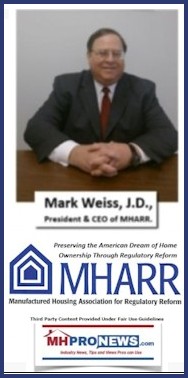
This unacceptable state of affairs will not change without aggressive push-back by – and on behalf of – the industry’s post-production sector. Quite simply, in 2019, that is where the problems are that limit the potential of the mainstream manufactured housing market, and, with it, the growth of the industry to where it should be. The existing scenario for the post-production sector is a façade that primarily serves the narrow interests of the industry’s largest corporate conglomerates while smaller businesses – and lower and moderate-income American families — suffer the consequences. This situation must change. But for that to occur, industry members must reject the “fluff” that they are constantly peddled, confront the “stubborn facts” that will not just go away otherwise, and demand real, aggressive action on these and a full-range of other post-production issues. ##
Mark Weiss
Part II
The above is from the MHARR website at this link here. The post-production sector is represented at the national level by the Manufactured Housing Institute (MHI), which is not directly named, but is apparently implied. MHARR represents independent producers of manufactured homes, so, they are the production sector, and not the post-production sector. The new publication Weiss mentions appears to be MHInsider, an arm of an MHI member firm that was described by legal researcher Samuel Strommen as the de facto house organ for MHI. And the call for a boycott – which can be an antitrust violation – was made publicly days earlier by MHI member and blogger, George Allen.
To some of the points raised by Weiss, see several of the reports for the week that was from 9.3 to 9.10. 2023, plus the postscript for today.
What’s New on MHLivingNews
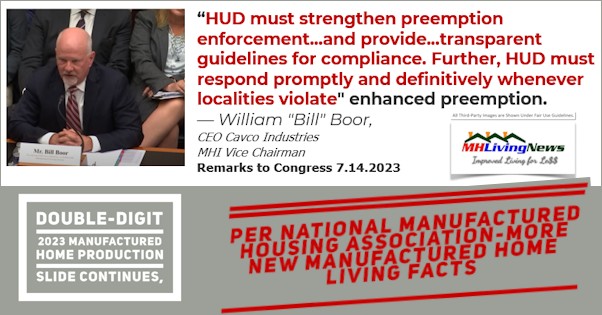


What’s New from Washington, D.C. from MHARR
Double-Digit 2023 Manufactured Home Production Slide Continues
MHI Statement Provides Fannie and Freddie a Pass on DTS Chattel
What’s New or Recent on the Masthead


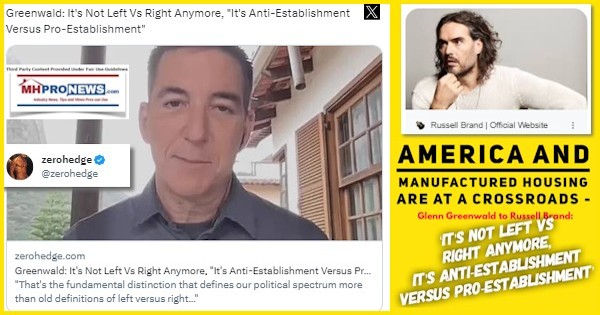
What’s New on the Daily Business News on MHProNews
Saturday 9.9.2023
Friday 9.8.2023
Thursday 9.7.2023
Wednesday 9.6.2023
Tuesday 9.5.2023
Monday 9.4.2023
Sunday 9.3.2023
Part III = Postscript
It bears mention that our critiques of MHI, and of specific MHI members, began while this publication’s parent company (LifeStyle Factory Homes LLC) was still an MHI member. It began while this writer sat on an MHI board (elected to that spot by industry peers), and while several MHI members were advertisers/sponsors. So, while Weiss had a point that some who perceive that they benefit from the status quo don’t criticize MHI and/or their dominating brands that do apparently benefit from the status quo. But that doesn’t, or didn’t apply to all, as our firm exemplified.
That said, all too often as Weiss put it: the MHI narrative de jour is “repeated and touted by those who, for whatever reason, have determined that it is to their advantage to do so.”
The “Illusion of Motion” is a method for posturing efforts that ultimately lead nowhere with respect to MHI’s stated claims to represent “all segments” of the industry, save more industry consolidation. The “illusion of motion” is thus an apparent ruse.
It should also be noted that fear is a factor for some in this scenario not distinctly mentioned by Weiss. When thousands of industry firms vanished in the first decade of the 21st century, and the only remaining lenders are MHI members, well, that’s a strong motivation for public silence by smaller firms. For instance. Don’t expect those who depend on a Berkshire Hathaway owned lender to publicly denounce 21st Mortgage or Clayton Homes, to mention but two possible scenarios.
Manufactured housing professionals who read MHProNews regularly and who accept – or are open to accepting to whatever degree – the thesis that MHI is posturing and paltering with the goal of appearing to look like they are saying something similar to MHARR, while at the same time MHI leaders are coyly working for the benefit of consolidators. It is a ploy that by its nature must operate in plain sight, as do all sorts of con games through the centuries. As MHProNews has previously noted, some massive cons operated in plain sight in the U.S. for years. They arguably included, but are not limited to, the VW “Dieselgate,” Theranos, Madoff, Enron, WorldCom, and others. Then in those cases just as more recently in MHVille, there were reportedly a kind of ‘fear’ on the part of some who suspected the Madoff scam (for instance) kept them from acting. Nevertheless, fear did not hold back whistleblowing by Harry Markopolos.
So, Madoff and the other examples illustrate the point that what has been, and is occurring, in MHVille is hardly new in American history. Some will stand up, others will wait and see.
That said, some in MHVille may indeed have been ‘fooled’ for a time by the purported MHI ruse.
The ruse might work better on outsiders looking in, which is an advantage of sorts for MHI’s public ‘credibility.’ The fact that there is now a major antitrust suit that involves several MHI members and mentions MHI may begin the unraveling of the industry’s insiders ‘cover.’ Time will tell. Programming note: MHLivingNews plans a detailed look at the pleadings in that case. Note too, thus far, neither MHI, nor their outside attorneys, nor some of their key members have responded to inquiries about that antitrust suit. Stay tuned.
So that said, remarks by MHARR, by accident and/or design, as well as several pointed articles by MHProNews/MHLivingNews over the past roughly 6 years point out what’s going wrong in the manufactured housing industry, the underlying causes, and possible cures.
What has MHI and their insiders done in response? This column on the Illusion of Motion by Weiss illustrated several useful points that answer that question. One is the repetition of MHI’s narrative, as if the critics of MHI and their leadership are supposed to be simply ignored.
With that tee up, a pro-MHI trade publication was launched to compete with MHProNews, as Weiss said. While Weiss didn’t bother to mention George Allen, he seemed to be implied in the reference Weiss made to a boycott. For context, Allen for a time was on the outs with MHI. But per sources and evidence, they apparently made a deal, and in the wake of that deal, Allen and associated meetings he is involved with get MHI member sponsors. Allen apparently in return is used or acts as a periodic foil or catspaw to attack whatever MHI’s insiders might find useful. The other dancing, prancing, and antics by Allen are apparently just part of the side show.
But blogger Allen arguably made several mistakes in his call for a boycott. Allen is still tossing periodic barbs – sometimes by name – at MHProNews. The remarks from Allen’s blog in late December 2018 appeared to be what MHARR’s Weiss was referring to in slamming the call for a boycott of this publication. Here is what Allen wrote on 12.27.20178, which again as noted, could be an antitrust violation – and may arguably part of the evidence for an ongoing ‘conspiracy’ alleged in the new case against linked in the headlines above, and in concerns raised by others within the industry.
Per Allen, on the date as noted, the following.

No names here, but hope you too boycott an ongoing online MH-related news media attempt to denigrate and divide us as an industry and realty asset class!
In my opinion, life is too short to be making crass and obtuse claims of national advocacy conspiracy, corporate antitrust imaginations, and disgusting personal attacks, only befouling internet platforms better used to promote manufactured housing and the land lease community lifestyle!
Is there anyone who doesn’t see how much of what’s being put forth as industry ‘news’ is little more than thinly-veiled efforts, on the part of one industry advocate, to smear and denigrate another?
If so, join me in 2019, committing to read only print and online trade publications advancing the causes, and improving the image, of HUD-Code manufactured housing and land lease communities! No more caterwauling (‘to fight like cats’) in public and in private. Period.”
Ironically, Allen, some years later, in his quirky bobbing and weaving manner, later praised MHProNews and this writer. Whatever harm the boycott may have done, it is fair to say that our publication endured.
All of this may prove useful in the pending and other possible looming antitrust or other cases involving MHI and MHI backers. It is also an illustration that if we can do it, others in MHVille have, can, and will do what it takes to endure – or even thrive – too.

But Allen himself has been questioned about his apparent efforts at acting as a bar to competition, proven and new thinking, and his desire to act as a ‘gatekeeper’ – particularly in his segment of MHVille. His outrageous roughly weekly claims are either laughably self-centered, and/or indicative of a purportedly MHI-style monopolistic mindset, take your pick. From that same post where Allen apparently called for a boycott of MHProNews, “GFA” (George F. Allen) wrote earlier in part: “This blog posting is the sole national advocate, voice, official ombudsman, historian, research reporter, and online communication media for all North American land lease communities!” Phew! With Allen around, should God the Almighty worry about His job? Talk about an inflated ego…
But as MHProNews has pointed out, the meetings that Allen organizes have long been billed by Allen himself as a resource for “deal making.”
Put differently, Allen and SECO have arguably created a feeding ground for consolidators, who gladly help co-sponsor such events. The consolidators may care less what Allen says, so long as they get a chance to network with companies that want to sell out. While portraying himself as a kind of leader-savior, it is an apparently faux pose. How so? Because he won’t do what he ought to do if he sincerely wanted the long term best interests of all independents. For example, Allen has been accused by some in MHVille of thwarting the formation of a post-production trade group. Isn’t that type of behavior music to MHI’s and their consolidators ears?
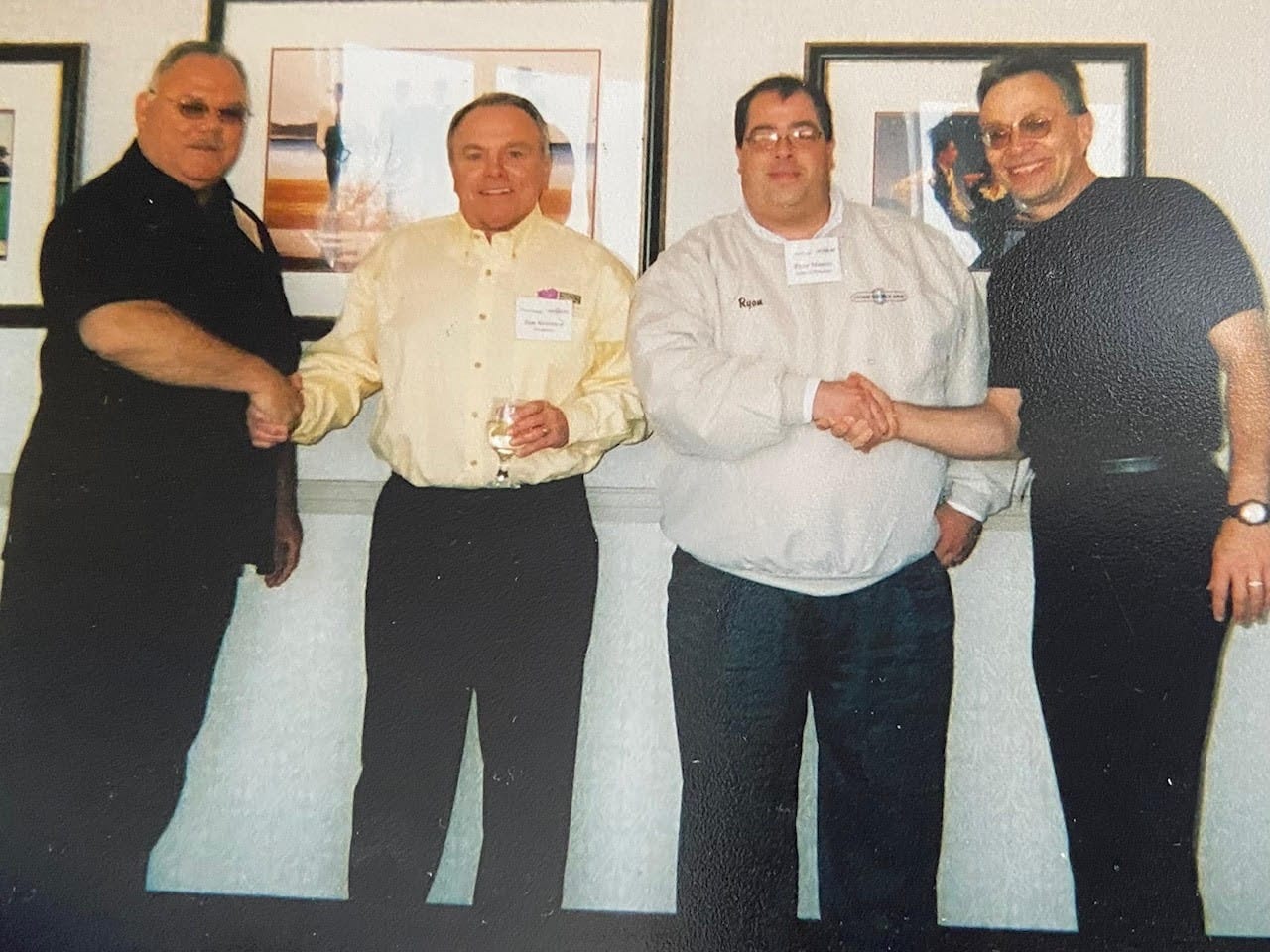
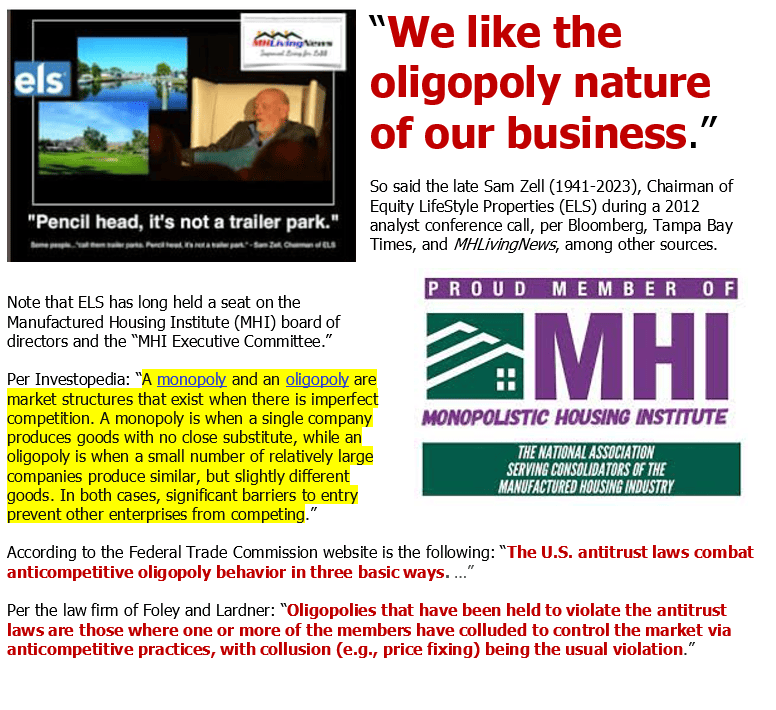
There is ample evidence of antitrust violations involving several MHI members, and MHI itself.
- Monopolization or antitrust concerns were raised by the MHIdea.
- Antitrust violations were raised by Knudson Law’s legal researcher Samuel “Sam” Strommen.
- They have been raised by James A. “Jim” Schmitz Jr. who is a professor and works for the Minneapolis Federal Reserve.
The fact that others who happen to be publishers or bloggers in the MHI orbit ignore or attempt to distract from or ignore monopolization and antitrust is in a sense part of the evidence-based arguments that some level of ongoing collusion is occurring.
Don’t some industry pros still have to navigate how they might step up to the plate for forming a new post-production trade group without exposing themselves? The MHARR model may offer an option that could work for the initial years, before 990s have to be published.
Low production, few options for manufactured home placement, these are barriers of entry and persistence in manufactured housing. Is it any surprise that the industry’s production has been kept so low for so long? Given that oligopoly style monopolization often leads – per experts – to poorer service and higher costs, is it any surprise that manufactured home residents are victims of predatory brands routinely connected to MHI and/or MHI linked state associations?
So, is it any surprise that the runaway #1 topic on the industry’s largest and apparently most read trade media is MHProNews report on an antitrust suit vs. several MHI members?
Now that an actual antitrust case is underway, and the possibility exists that other related litigation could follow. That may give a measure of security for industry pros to step up and be ready to join, help lead, or otherwise support a new post-production trade group. That forming of a new post-production trade group has long been championed by MHARR.
MHI and their aligned member-voices such as MHInsider, ManufacturedHomes.com, Frank and Dave, or GFA are not informing you about manufactured housing. Rather, the case can be made that they are selling others on a narrative that serves a few while harming the many.
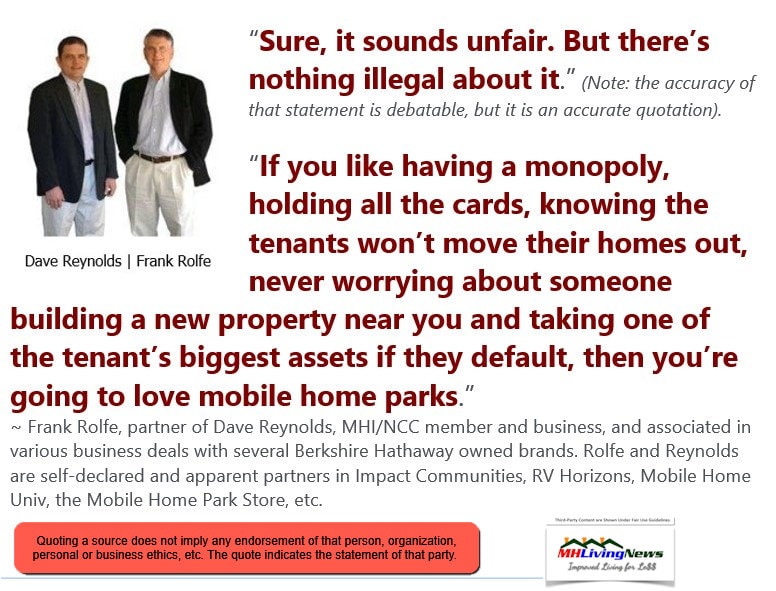
The evidence that they collectively are faux and self-serving leaders of a manufactured housing recovery is reported almost day by day on MHProNews. Why? Because the pattern in the 21st century can’t be much clearer, based on what Weiss aptly called in Illusion of Motion – those pesky facts.
Past and ongoing evidence of purported antitrust violations that foster consolidation are routinely ignored or denied, while opportunities for growth are routinely frittered away. The two graphics below speaks volumes for those with the eyes to see. Note both of those graphics can be opened to a larger size, see the instructions below the graphics or click the image and follow the prompts.
Notice: the graphic below can be expanded to a larger size.
See the instructions below the graphic below or click the image and follow the prompts.
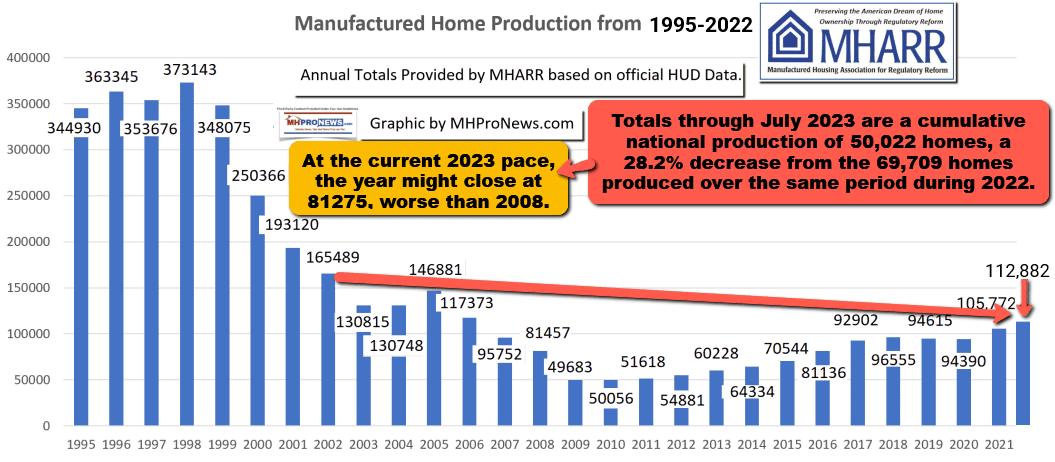
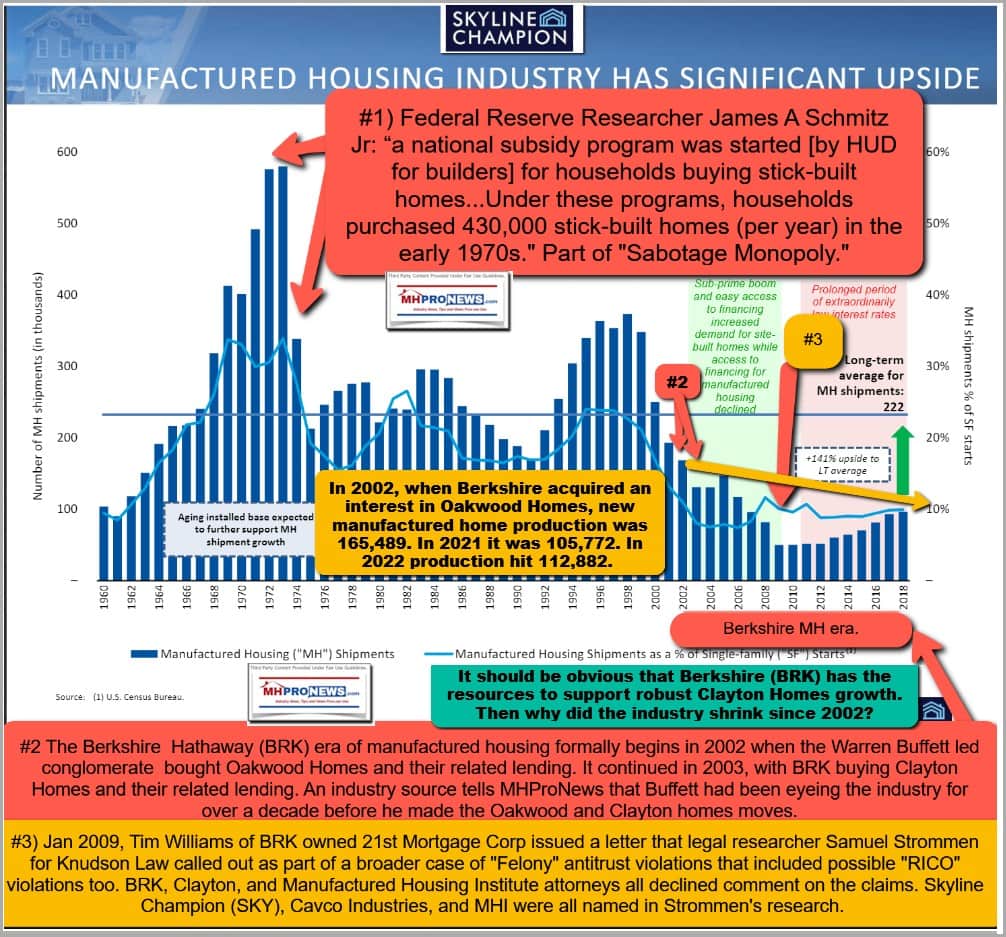
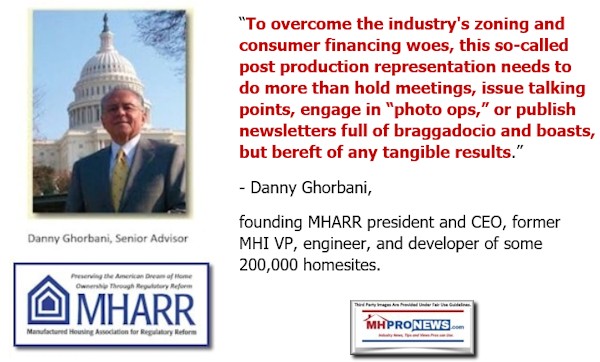
MHProNews has a long history of supporting a robust and healthy manufactured housing market growth, so long as good existing laws are being robustly enforced. We have long exposed examples of possible antitrust, Hobbs Act, RICO, and other possible violations of law and constitutionally protected rights.
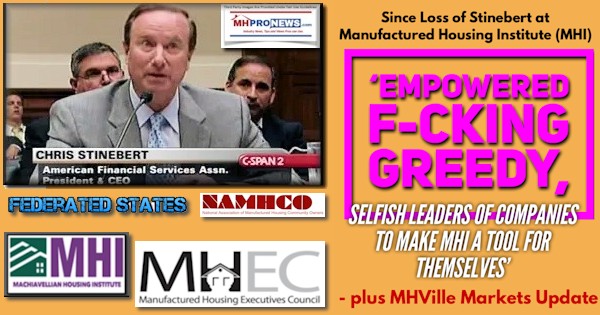
While we have and continue to expose the problems with our rivals and black hats in our industry, we don’t call for their formal boycott. We defend the first amendment rights of MHI, and their members like MHInsider, ManufacturedHomes.com, Frank and Dave, or GFA to peacefully and lawfully speak out via their respective platforms. Because each arguably have a God-given and constitutionally protected right to be wrong. Their often comically self-serving and consolidator-benefiting tripe routinely make MHProNews/MHLivingNews look better and wiser. Thanks, fellas. ###
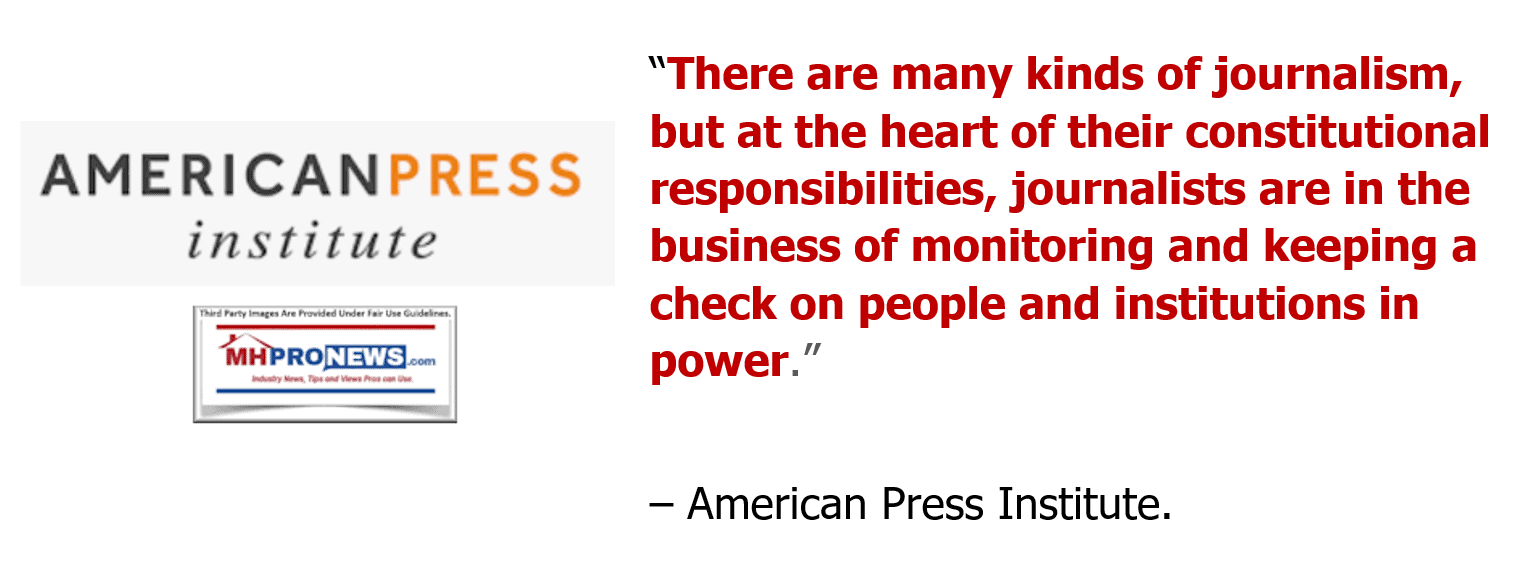

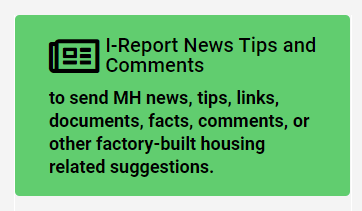
Again, our thanks to free email subscribers and all readers like you, as well as our tipsters/sources, sponsors and God for making and keeping us the runaway number one source for authentic “News through the lens of manufactured homes and factory-built housing” © where “We Provide, You Decide.” © ## (Affordable housing, manufactured homes, reports, fact-checks, analysis, and commentary. Third-party images or content are provided under fair use guidelines for media.) See Related Reports, further below. Text/image boxes often are hot-linked to other reports that can be access by clicking on them.)

By L.A. “Tony” Kovach – for MHProNews.com.
Tony earned a journalism scholarship and earned numerous awards in history and in manufactured housing.
For example, he earned the prestigious Lottinville Award in history from the University of Oklahoma, where he studied history and business management. He’s a managing member and co-founder of LifeStyle Factory Homes, LLC, the parent company to MHProNews, and MHLivingNews.com.
This article reflects the LLC’s and/or the writer’s position and may or may not reflect the views of sponsors or supporters.
Connect on LinkedIn: http://www.linkedin.com/in/latonykovach
Related References:
The text/image boxes below are linked to other reports, which can be accessed by clicking on them.’
